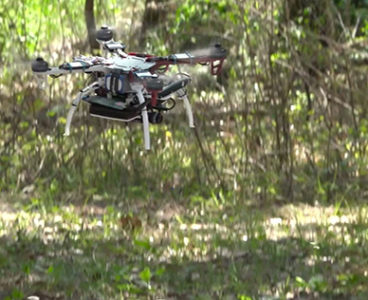Underground settings are becoming increasingly relevant to global security and safety. Rising populations and urbanization are requiring military and civilian first responders to perform their duties below ground in human-made tunnels, underground urban spaces, and natural cave networks. Recognizing that innovative, enhanced technologies could accelerate development of critical lifesaving capabilities, DARPA today announced its newest…
Ocean of Things Aim to Expand Maritime Awareness Across Open Seas
The internet of things connects an ever-growing number of smart devices for up-to-the-minute monitoring and tracking of many common events. Head out to most parts of the open ocean, however, and no such capability exists for real-time monitoring of maritime activity. DARPA today announced its Ocean of Things program, which seeks to enable persistent maritime…
DARPA Digging for Ideas to Revolutionize Subterranean Mapping and Navigation
Developing “ABCs” for Exploiting New Phenomena in Light-Matter Interactions
A unique class of engineered light-manipulating materials, known as metamaterials or structured materials, makes use of patterns of strongly interacting wavelength or sub-wavelength-sized elements. Because of these intricate internal and surface structures, new properties have emerged, some exhibiting behavior that has resulted in rewriting long-understood “laws” for how light and other electromagnetic (EM) waves interact…
DARPA Rolls Out Electronics Resurgence Initiative
With the official roll out today of the Electronics Resurgence Initiative’s latest investments, DARPA hopes to open new innovation pathways to address impending engineering and economics challenges that, if left unanswered, could challenge what has been a relentless half-century run of progress in microelectronics technology. To maintain healthy forward momentum, ERI over the next four…
DARPA Launches Assured Autonomy Program
Building on recent breakthroughs in autonomous cyber systems and formal methods, DARPA today announced a new research program called Assured Autonomy that aims to advance the ways computing systems can learn and evolve to better manage variations in the environment and enhance the predictability of autonomous systems like driverless vehicles and unmanned aerial vehicles (UAVs).…
Building the Safe Genes Toolkit
DARPA created the Safe Genes program to gain a fundamental understanding of how gene editing technologies function; devise means to safely, responsibly, and predictably harness them for beneficial ends; and address potential health and security concerns related to their accidental or intentional misuse. Today, DARPA announced awards to seven teams that will pursue that mission, led…
Smart Quadcopters Find Their Way Without Human Help or GPS
Phase 1 of DARPA’s Fast Lightweight Autonomy (FLA) program concluded recently following a series of obstacle-course flight tests in central Florida. Over four days, three teams of DARPA-supported researchers huddled under shade tents in the sweltering Florida sun, fine-tuning their sensor-laden quadcopter unmanned aerial vehicles (UAVs) during the intervals between increasingly difficult runs. DARPA’s FLA…
Researchers Develop Advanced Battle Management Tools, Interactive Visual Environment
New Ways of Representing Information Could Transform Digital Technology
Many people who use computers and other digital devices are aware that all the words and images displayed on their monitors boil down to a sequence of ones and zeros. But few likely appreciate what is behind those ones and zeros: microscopic arrays of “magnetic moments” (imagine tiny bar magnets with positive and negative poles).…
Extracting Insight from the Data Deluge Is a Hard-to-Do Must-Do
A mantra of these data-rife times is that within the vast and growing volumes of diverse data types, such as sensor feeds, economic indicators, and scientific and environmental measurements, are dots of significance that can tell important stories, if only those dots could be identified and connected in authentically meaningful ways. Getting good at that…
Beyond Scaling: An Electronics Resurgence Initiative
The Department of Defense’s proposed FY 2018 budget includes a $75 million allocation for DARPA in support of a new, public-private “electronics resurgence” initiative. The initiative seeks to undergird a new era of electronics in which advances in performance will be catalyzed not just by continued component miniaturization but also by radically new microsystem materials,…
DARPA Picks Design for Next-Gen Spaceplane
Taking The Guesswork Out of Designing Extremely Complex Military Systems
Turning to Chemistry for New ‘Computing’ Concepts
As the complexity and volume of global digital data grows, so too does the need for more capable and compact means of processing and storing data. To address this challenge, DARPA has announced its Molecular Informatics program, which seeks a new paradigm for data storage, retrieval, and processing. Instead of relying on the binary digital…
DARPA Completes Testing of Subscale Hybrid Electric VTOL X-Plane
DARPA has completed flight-testing of a sub-scale version of a novel aircraft design as part of its vertical takeoff and landing (VTOL) X-Plane program, and is proceeding with work to develop a full-scale version of the groundbreaking plane. Developed and fabricated by Aurora Flight Sciences, the revolutionary aircraft includes 24 electric ducted fans—18 distributed within…
Turning to Chemistry for New ‘Computing’ Concepts
As the complexity and volume of global digital data grows, so too does the need for more capable and compact means of processing and storing data. To address this challenge, DARPA has announced its Molecular Informatics program, which seeks a new paradigm for data storage, retrieval, and processing. Instead of relying on the binary digital…
ALIAS Pushes the Envelope on Aircraft Automation
DARPA’s Aircrew Labor In-Cockpit Automation System (ALIAS) program envisions flight operations with reduced onboard aircrew while improving mission performance and flight safety—all through a tailorable, drop-in, removable kit that would provide advanced automation to existing aircraft. In two important steps toward that goal, DARPA has recently completed Phase 2 of this development effort and has decided to…
OFFSET Envisions Swarm Capabilities for Small Urban Ground Units
DARPA Enlists Insects to Protect Agricultural Food Supply & Commodity Crops
Keeping a Watchful Eye on Low-Flying UAS’s in Cities
Airspace for the flying public today is perpetually congested yet remarkably safe, thanks in no small part to a well-established air traffic control system that tracks, guides and continuously monitors thousands of flights a day. When it comes to small unmanned aerial systems (UAS) such as commercial quadcopters, however, no such comprehensive tracking system exists.…
Living Structural Materials Could Open New Horizons for Architects, Engineers
The structural materials that are currently used to construct homes, buildings, and infrastructure are expensive to produce and transport, wear out due to age and damage, and have limited ability to respond to changes in their immediate surroundings. Living biological materials—bone, skin, bark, and coral, for example—have attributes that provide advantages over the non-living materials…




















